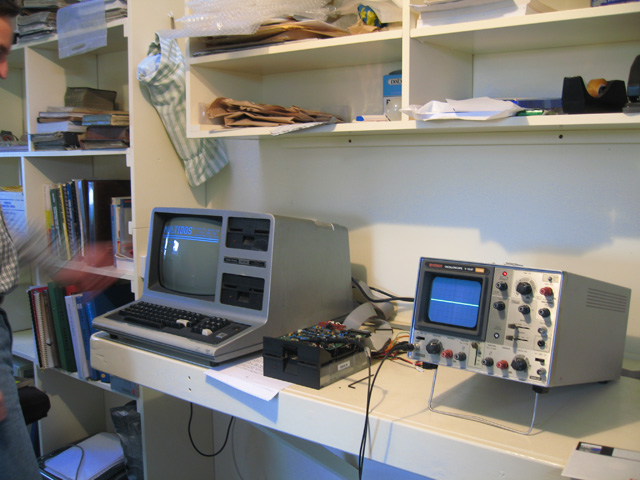Tandon TM100 -2A disk drive alignment on an IBM-PC (5150)
 Introduction
Introduction
Every few months or so I boot up each of my computers and give them a six-hour workout. This helps keep the capacitors fresh and also lets me see if there are any developing problems.
I've come to dread doing this with my IBM-PC. Although it's museum quality both inside and out, it can be a petulant beast! When it first arrived, the screen started to blank out. That was fixed. The drives then started to play up. A bit of lubrication solved that problem. The last time I switched it on for a workout, it threw a RAM chip. The offending item was identified and replaced.
The day had rolled around to drag it out for some exercise. I wondered if anything would go wrong. Surely such a fine physical specimen with the reputation of quality that is IBM would be fine by now? I inserted a PC-DOS 2.1 disk into drive A, confidently threw the big red switch and waited. The cursor blinked reassuringly as the unit checked its 256k RAM, the drive A light flashed and then...ROM BASIC??? What the??.
Diagnosis
Boot failure can have many reasons. A damaged disk controller, a damaged drive or damaged disks are all possibilities. The trick is to narrow down the fault. I did some experimenting. First I swapped drives over and rebooted. This time I got a perfect boot. This means the controller and disk were ok. The problem was with the drive itself.
Leaving the "good" drive set as drive A, I did some experimenting. I found that the faulty drive could format disks just fine, and read and write to them. It could even boot off a DOS disk it had prepared itself. However, it could not read my existing disks. Furthermore the good drive could not read any disk prepared on the faulty disk. All these symptoms pointed to the radial alignment being incorrect in the faulty drive.
The Fix
Radial alignment. It's the bane of all owners of these old disk-based machines. The reason being that radial alignment normally requires a special alignment disk, an object of antiquity which is now rare! Fortunately there is a work-around which allows alignment without the special disk. It was applied on my Kaypro II drive by friend and fellow vintage computer enthusiast Philip Avery to excellent effect. Time to touch base with Philip and organised another Tandon TM100 -2A drive-saving visit!
Philip uses a TRS-80 Model 3, software called Floppy Doctor and an oscilloscope to apply this procedure. His setup can be seen in Figure 1. That's my Tandon TM100 -2A drive in the centre.

Figure 1. Philp Avery's drive alignment centre (Alignment disks optional)
Philip applied the same method he used on my Kaypro drives (Figure 2). Here he is hard at work twiddling the necessary screws. This time I looked over his shoulder to see exactly what was needed.

Figure 2. Philip aligning the Tandon TM100 -2A drive extracted from my IBM PC
This technique can be applied to any Tandon TM100 -2A drive. These drives appear on many vintage machines. With this in mind, rather than spell out the details here, Philip wrote up the procedure and I've added it to my blogspace as a separate article.
The result was a complete success! The aligned drive was re-inserted into the machine and given a heavy workout. No errors whatsoever. The drive could now boot from my existing PC-DOS disks and disks prepared on the drive could be read in the second drive and vice versa. The 5150 was restored to full health!
Reflections
The alignment procedure is a handy one. However, it still requires an oscilloscope, software and a machine you can hook the test drive up to. These seem more common than alignment disks though, although a scope is still needed with both.
One more Tandon TM100 -2A saved from the trash and my IBM-PC is once more a jewel in the crown of my collection. Until the next time I boot it up perhaps. (-:
Tez
29th June, 2010
| Tweet |